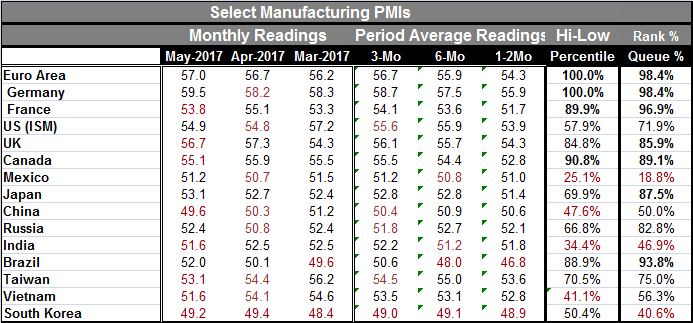 Global| Jun 01 2017
Global| Jun 01 2017Manufacturing PMIs Show Step Back in Much of Asia
Summary
The euro area showed its manufacturing PMI gain in May as the manufacturing PMIs gains in three of the largest EMU economies. But there were step backs in 8 of these key 15 markets. There were also eight for which the three-month [...]
 The euro area showed its manufacturing PMI gain in May as the manufacturing PMIs gains in three of the largest EMU economies. But there were step backs in 8 of these key 15 markets. There were also eight for which the three-month average stepped back last month as well. Only five countries show weaker results over three months than over six months. But these are significant five countries: the U.S., China, South Korea (whose PMI is also below 50), Taiwan, and Russia. However, only China and Russia have three-month readings below their 12-month average readings. That means that broadly conceived positive momentum is still in train.
The euro area showed its manufacturing PMI gain in May as the manufacturing PMIs gains in three of the largest EMU economies. But there were step backs in 8 of these key 15 markets. There were also eight for which the three-month average stepped back last month as well. Only five countries show weaker results over three months than over six months. But these are significant five countries: the U.S., China, South Korea (whose PMI is also below 50), Taiwan, and Russia. However, only China and Russia have three-month readings below their 12-month average readings. That means that broadly conceived positive momentum is still in train.
In addition, only three of the reporters have manufaturing PMIs below their median values since January 2012. These are Mexico, India, and South Korea.
Seven countries/regions have queue or rank standings in the top 15% of all values since January 2012. This is a very solid set of readings. The euro area, Germany, and France are near the top of the list. Brazil is also strong on this relative sale as are Canada, the U.K., and Japan. But apart from Brazil, the list is very much weighted to Europe. Canada trades a great deal with the U.S. and the U.K., two countries that stepped back on the month. Brazil is showing a relative reading that is high despite a low absolute level of reading as it is in the early stages of dealing with problems that have been plaguing it. The central bank in Brazil just cut its key Selic lending rate by 100bp today.
Despite these high ratings for much of Europe, the ECB has been making news this week as Mario Draghi has been insisting that the EMU still needs a stimulative monetary policy. That acknowledgment puts the high PMI rating for Europe in a different light. Its performance is better than it has been, but Europe is still not firing on all cylinders.
Globally, growth is being damped. Global demographics a real issue as populations are maturing and aging. Developing economies are trying to ride production increases based on export-led growth to faster development. But this process undercuts the developing economies that are the source of the demand. As developed economics run bigger trade deficits, they become more indebted, workers are displaced and growth slows. This 'development model' has been in its final days for some time. The global financial crisis has helped to under cover its unsustainable folly. Developing countries wishing to grow faster need to develop more balanced models of growth. For the time being, there appears to be too little demand to satisfy everyone and that is breeding conflict.

Robert Brusca
AuthorMore in Author Profile »Robert A. Brusca is Chief Economist of Fact and Opinion Economics, a consulting firm he founded in Manhattan. He has been an economist on Wall Street for over 25 years. He has visited central banking and large institutional clients in over 30 countries in his career as an economist. Mr. Brusca was a Divisional Research Chief at the Federal Reserve Bank of NY (Chief of the International Financial markets Division), a Fed Watcher at Irving Trust and Chief Economist at Nikko Securities International. He is widely quoted and appears in various media. Mr. Brusca holds an MA and Ph.D. in economics from Michigan State University and a BA in Economics from the University of Michigan. His research pursues his strong interests in non aligned policy economics as well as international economics. FAO Economics’ research targets investors to assist them in making better investment decisions in stocks, bonds and in a variety of international assets. The company does not manage money and has no conflicts in giving economic advice.






